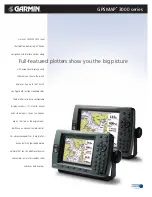
12-36
Garmin GTN 725/750 Pilot’s Guide
190-01007-03 Rev. D
Foreword
Getting
Started
Audio &
Xpdr Ctrl
Com/Nav
FPL
Direct-To
Proc
Charts
Wpt Info
Map
Traffic
Terrain
Weather
Nearest
Services/
Music
Utilities
System
Messages
Symbols
Appendix
Index
12.3.2.2 Ground Returns
The intensity of ground target returns depends upon the angle at which the
radar beam strikes the ground target (Angle of Incidence) and the reflective
properties of that target. The gain can be adjusted so shorelines, rivers, lakes,
and cities are well defined. Increasing gain too much causes the display to fill in
between targets, thus obscuring some landmarks.
Cities normally provide a strong return signal. While large buildings and
structures provide good returns, small buildings can be shadowed from the
radar beam by the taller buildings. As the aircraft approaches, and shorter ranges
are selected, details become more noticeable as the highly reflective regular lines
and edges of the city become more defined.
Bodies of water such as lakes, rivers, and oceans are not good reflectors,
and normally do not provide good returns. The energy is reflected in a forward
scatter angle with inadequate energy being returned. They can appear as dark
areas on the display. However, rough or choppy water is a better reflector and
will provide stronger returns from the downwind sides of the waves.
Mountains also provide strong return signals to the antenna, but also block
the areas behind. However, over mountainous terrain, the radar beam can be
reflected back and forth in the mountain passes or off canyon walls using up all
or most of the radar energy.
In this case, no return signal is received from
this area causing the display to show a dark spot which could indicate a
pass where no pass exists.
12.3.2.3 Angle of Incidence
The angle at which the radar beam strikes the target is called the Angle of
Incidence. Incident angle (“A”) is illustrated below. This directly affects the
detectable range, the area of illumination, and the intensity of the displayed target
returns. A large incident angle gives the radar system a smaller detectable range
and lower display intensity due to minimized reflection of the radar energy.
Содержание GTN 725
Страница 553: ......















































